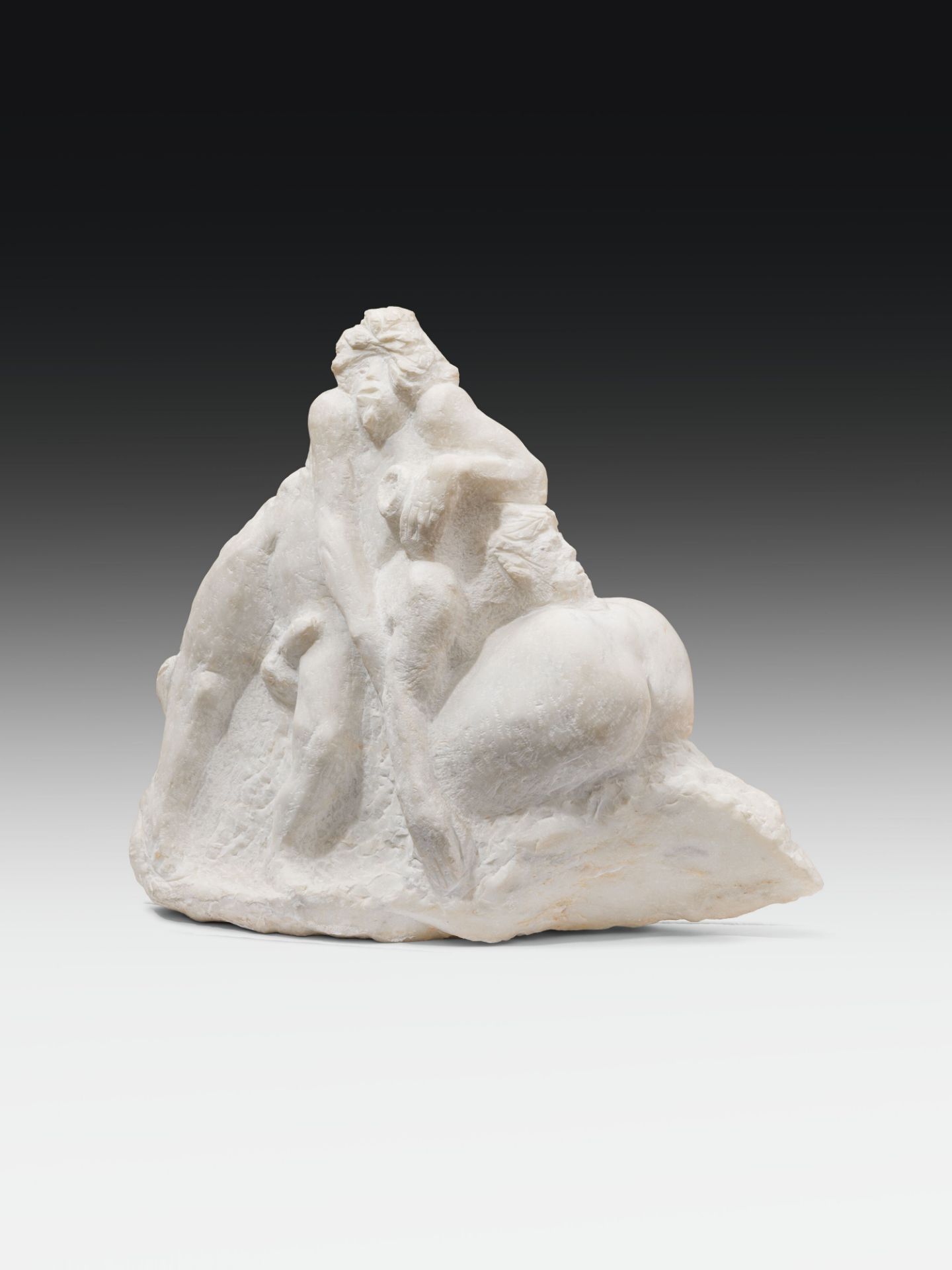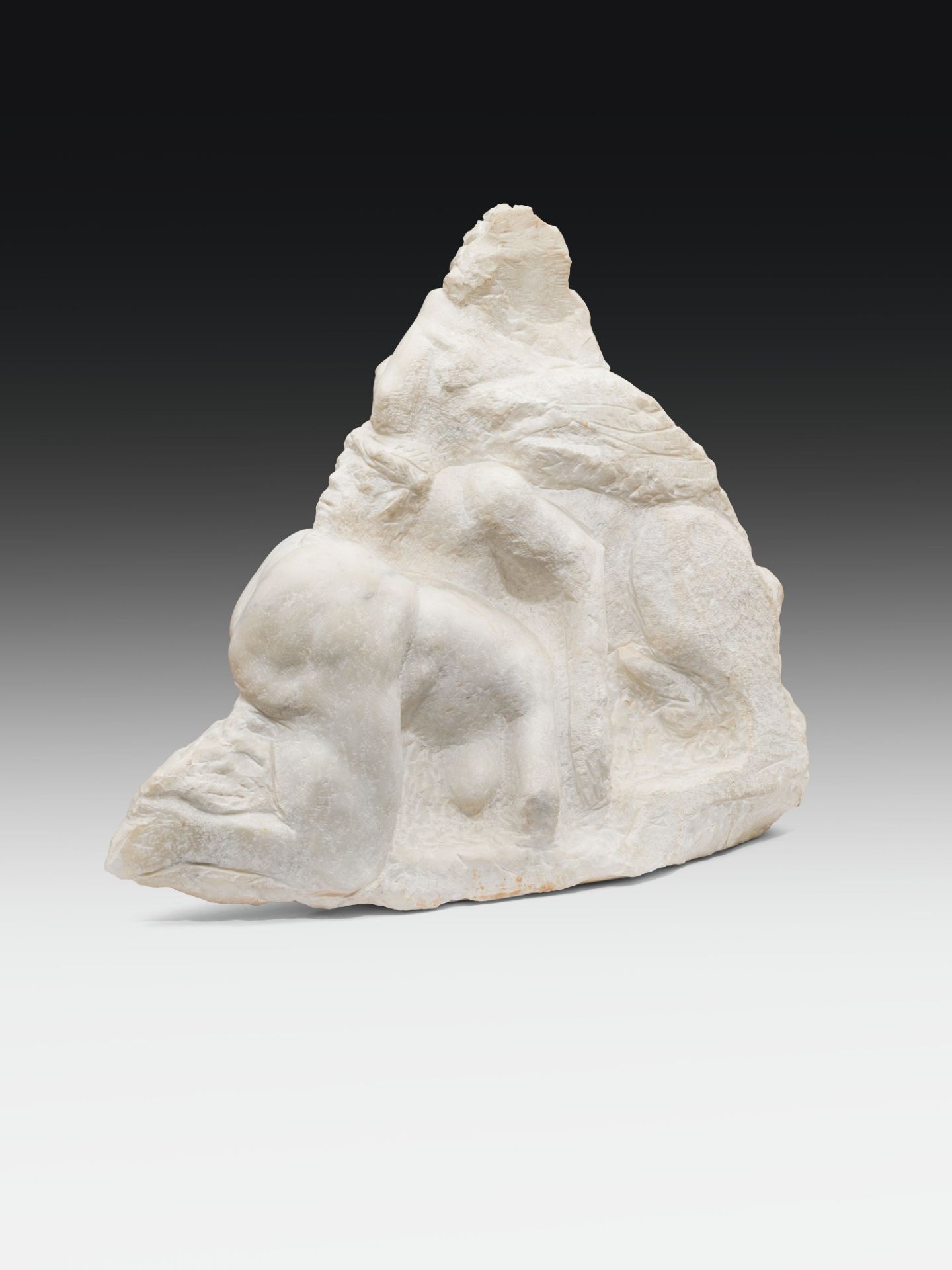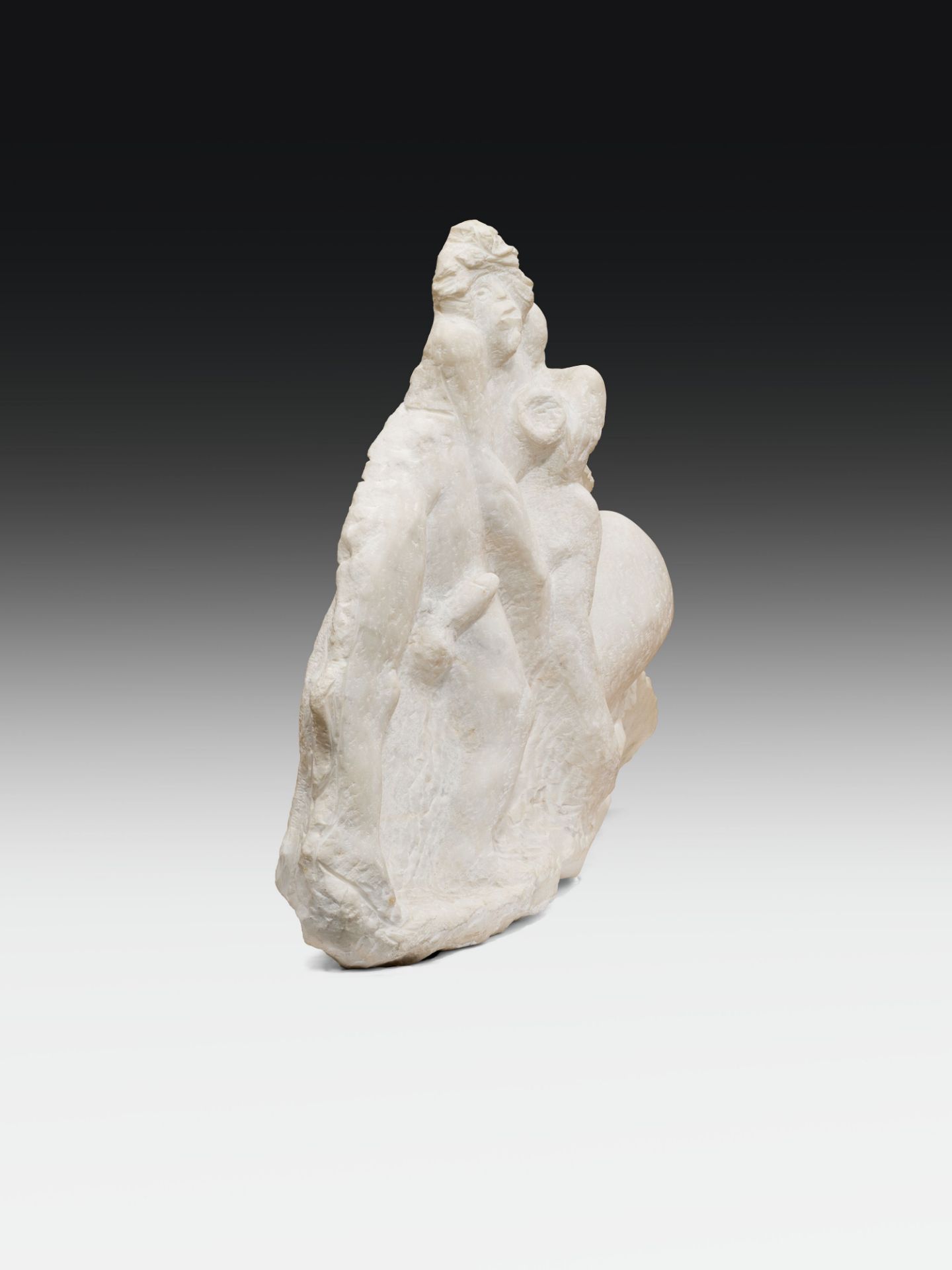54
Alfred Hrdlicka: Trunkener Silen
Alfred Hrdlicka
Trunkener Silen
1995
Marmor
80 x 88 x 25 cm
Galerie Ernst Hilger, Wien;
seither Sammlung Sanziany & Palais Rasumofsky, Wien
Klaus Klemp und Peter Weiermair (Hg.), Alfred Hrdlicka. Skulpturen Zeichnungen Druckgraphik 1945-1997, S. 44.
Der Wiener Bildhauer Alfred Hrdlicka zählte zu den letzten großen Künstlerpersönlichkeiten des 20. Jahrhunderts. Er hinterließ ein umfangreiches und komplexes Werk, das zwischen Bildhauerei, Malerei und Grafik pendelte. Anders als viele seiner Zeitgenossen orientierte sich Hrdlicka nicht an der Abstraktion, sondern verfolgte eine klassische Formensprache in expressiver Figürlichkeit. Zu Hrdlickas Hauptwerken zählt das monumentale Mahnmal gegen Krieg und Faschismus (1988) am Wiener Albertinaplatz. Die Skulptur Trunkener Silen entstand nur wenige Jahre später und zählt zu Hrdlickas gattungsübergreifendem Zyklus "Hommage à Géricault". In der Arbeit spiegelt sich nicht nur seine Bewunderung für den Künstler Théodore Géricault wider, sondern auch sein Faible für mythologische Themen. Die Plastik ist gekennzeichnet durch eine figürliche Formensprache in expressiver Manier. Über sein Schaffen schrieb Hrdlicka einst: "Bildhauerei demonstriert Körpergefühl, ist Schaustellung der eigenen Physis und Neigungen, nahe am Striptease, dessen Technik der partiellen Freilegung, Entblößung, Bloßlegung der ‚taille directe‘, der unmittelbaren Arbeit in Stein, dem allmählichen Heraustreten der Figur aus dem Block, wesensverwandt ist. So sind die meisten meiner Skulpturen, auch die ‚Vollständigen‘, Bruchstücke eines Geschehens, herausgebrochene Momentaufnahmen, zugehörig einem Zyklus oder Bewegungsrhythmus" (Michael Lewin (Hg.), Alfred Hrdlicka. Das Gesamtwerk. Schriften, Wien 1987, S. 106). Die Skulptur Trunkener Silen stammt aus der hochkarätigen Sammlung Sanziany & Palais Rasumofsky in Wien. Vom Objekt existiert noch eine Bronzeauflage mit 9 Stück. Aufgrund ihrer Materialität und Wirkung nimmt die Marmorskulptur einen exklusiven Stellenwert in Hrdlickas Werk ein.
(Stefan Üner)
Alfred Hrdlicka
Drunken Silenus
1995
marble
80 x 88 x 25 cm
Galerie Ernst Hilger, Vienna;
since then collection Sanziany & Palais Rasumofsky, Vienna
Klaus Klemp and Peter Weiermair (ed.), Alfred Hrdlicka. Skulpturen Zeichnungen Druckgraphik 1945-1997, p. 44.
The Viennese sculptor Alfred Hrdlicka was one of the last great artistic personalities of the 20th century. He left behind an extensive and complex oeuvre that alternated between sculpture, painting and graphics. Unlike many of his contemporaries, Hrdlicka did not pursue abstraction, but rather a classical language of form in an expressive figurativeness. Among Hrdlicka’s major works is the monumental Mahnmal Gegen Krieg und Fascismus ("Memorial Against War and Fascism", 1988) at Vienna’s Albertinaplatz. The sculpture Trunkener Silen ("Drunken Silenus") was created only a few years later and is part of Hrdlicka’s cross-genre cycle Hommage à Géricault. The work reflects not only his admiration for the artist Théodore Géricault, but also his penchant for mythological themes. The sculpture is characterised by a figurative language of form in an expressive style. Hrdlicka once wrote about his work: "Sculpture demonstrates a feeling for the body, is a display of one’s own physique and inclinations close to a striptease, in which the technique of partial uncovering, divestment, exposure of the ‘taille directe’, the direct work of cutting the stone, the gradual emergence of the figure from the block, is essentially related. Thus, most of my sculptures, even the ‘complete’ ones, are fragments of an event, torn-out snapshots, belonging to a cycle or rhythm of movement" (Michael Lewin: Alfred Hrdlicka. Das Gesamtwerk. Schriften ["The Complete Works. Writings"], Vienna [i. a.] 1987, p. 106). The sculpture Trunkener Silen comes from the prestigious Sanziany & Palais Rasumofsky Collection in Vienna. A bronze edition of 9 pieces still exists of the object. Due to its quality of material and effect, the marble sculpture occupies an exclusive place in Hrdlicka’s oeuvre.
(Stefan Üner)
Alfred Hrdlicka
Trunkener Silen
1995
Marmor
80 x 88 x 25 cm
Galerie Ernst Hilger, Wien;
seither Sammlung Sanziany & Palais Rasumofsky, Wien
Klaus Klemp und Peter Weiermair (Hg.), Alfred Hrdlicka. Skulpturen Zeichnungen Druckgraphik 1945-1997, S. 44.
Der Wiener Bildhauer Alfred Hrdlicka zählte zu den letzten großen Künstlerpersönlichkeiten des 20. Jahrhunderts. Er hinterließ ein umfangreiches und komplexes Werk, das zwischen Bildhauerei, Malerei und Grafik pendelte. Anders als viele seiner Zeitgenossen orientierte sich Hrdlicka nicht an der Abstraktion, sondern verfolgte eine klassische Formensprache in expressiver Figürlichkeit. Zu Hrdlickas Hauptwerken zählt das monumentale Mahnmal gegen Krieg und Faschismus (1988) am Wiener Albertinaplatz. Die Skulptur Trunkener Silen entstand nur wenige Jahre später und zählt zu Hrdlickas gattungsübergreifendem Zyklus "Hommage à Géricault". In der Arbeit spiegelt sich nicht nur seine Bewunderung für den Künstler Théodore Géricault wider, sondern auch sein Faible für mythologische Themen. Die Plastik ist gekennzeichnet durch eine figürliche Formensprache in expressiver Manier. Über sein Schaffen schrieb Hrdlicka einst: "Bildhauerei demonstriert Körpergefühl, ist Schaustellung der eigenen Physis und Neigungen, nahe am Striptease, dessen Technik der partiellen Freilegung, Entblößung, Bloßlegung der ‚taille directe‘, der unmittelbaren Arbeit in Stein, dem allmählichen Heraustreten der Figur aus dem Block, wesensverwandt ist. So sind die meisten meiner Skulpturen, auch die ‚Vollständigen‘, Bruchstücke eines Geschehens, herausgebrochene Momentaufnahmen, zugehörig einem Zyklus oder Bewegungsrhythmus" (Michael Lewin (Hg.), Alfred Hrdlicka. Das Gesamtwerk. Schriften, Wien 1987, S. 106). Die Skulptur Trunkener Silen stammt aus der hochkarätigen Sammlung Sanziany & Palais Rasumofsky in Wien. Vom Objekt existiert noch eine Bronzeauflage mit 9 Stück. Aufgrund ihrer Materialität und Wirkung nimmt die Marmorskulptur einen exklusiven Stellenwert in Hrdlickas Werk ein.
(Stefan Üner)
Alfred Hrdlicka
Drunken Silenus
1995
marble
80 x 88 x 25 cm
Galerie Ernst Hilger, Vienna;
since then collection Sanziany & Palais Rasumofsky, Vienna
Klaus Klemp and Peter Weiermair (ed.), Alfred Hrdlicka. Skulpturen Zeichnungen Druckgraphik 1945-1997, p. 44.
The Viennese sculptor Alfred Hrdlicka was one of the last great artistic personalities of the 20th century. He left behind an extensive and complex oeuvre that alternated between sculpture, painting and graphics. Unlike many of his contemporaries, Hrdlicka did not pursue abstraction, but rather a classical language of form in an expressive figurativeness. Among Hrdlicka’s major works is the monumental Mahnmal Gegen Krieg und Fascismus ("Memorial Against War and Fascism", 1988) at Vienna’s Albertinaplatz. The sculpture Trunkener Silen ("Drunken Silenus") was created only a few years later and is part of Hrdlicka’s cross-genre cycle Hommage à Géricault. The work reflects not only his admiration for the artist Théodore Géricault, but also his penchant for mythological themes. The sculpture is characterised by a figurative language of form in an expressive style. Hrdlicka once wrote about his work: "Sculpture demonstrates a feeling for the body, is a display of one’s own physique and inclinations close to a striptease, in which the technique of partial uncovering, divestment, exposure of the ‘taille directe’, the direct work of cutting the stone, the gradual emergence of the figure from the block, is essentially related. Thus, most of my sculptures, even the ‘complete’ ones, are fragments of an event, torn-out snapshots, belonging to a cycle or rhythm of movement" (Michael Lewin: Alfred Hrdlicka. Das Gesamtwerk. Schriften ["The Complete Works. Writings"], Vienna [i. a.] 1987, p. 106). The sculpture Trunkener Silen comes from the prestigious Sanziany & Palais Rasumofsky Collection in Vienna. A bronze edition of 9 pieces still exists of the object. Due to its quality of material and effect, the marble sculpture occupies an exclusive place in Hrdlicka’s oeuvre.
(Stefan Üner)
Große Jubiläumsauktion: Evening Sale
Auktionsdatum
Ort der Versteigerung
Generelle Versandinformationen vom Auktionshaus verfügbar
If you do not wish to collect your pieces from us yourself, we will arrange delivery for you. Our specialist business partners are professionals in packing, insurance and delivery and will provide these services at advantageous rates. The after-sales service usually proceeds as follows:If you would like, after the auction our logistics department will give you a quotation for transport and insurance.
If you would like to take advantage of this delivery option, contact the logistics department, after you have paid the purchase price, T +43 1 5324200-18 or r.mayr@imkinsky.com
When you place your order, your details will be sent to the appropriate shipping company. You will be contacted by our business partner to arrange a delivery date.
The price for transport and insurance is arranged directly with the shipping company.
If you don’t want to take advantage of this service, we must ask you to arrange collection yourself. We ask for your understanding that in this case we can take no responsibility for the quality of packing or transportation and can therefore take no responsibility for whether your pieces arrive intact.
Wichtige Informationen
Exhibition 17-30 November
Mon-Fri 10am-6pm
Sat & Sun 10am-5pm
AGB
Conditions of Auction
Extract from the rules of procedure
The wording of the complete rules of procedure can be viewed on our homepage www.imkinsky.com. By request we will also send the rules of procedure to you.
• Rules of Business: Auctions are conducted according to the conditions of sale as set down by Auktionshaus im Kinsky GmbH. The rules of business are available for viewing at the Auction House, and can be requested by post or email (office@imkinsky.com), they can also be called up on the internet under www.imkinsky.com.
• Estimates: In the catalogues the lower and upper estimated values are indicated and represent the approximate bid expectations of the responsible experts.
• Reserves (Limits): Sellers quite often appoint the auction house, not to sell their objects beneath certain price. These prices (= reserve/limit) usually match the lower estimate, but in special situations can also surpass them.
• Guarantee of Authenticity: The valuation, as well as technical classification and description of the art objects is carried out by the specialists of Auktionshaus im Kinsky. Auktionshaus im Kinsky guarantees the purchaser the authenticity for three years – i.e. that the authorship of the art object is as set out in the catalogue.
• Catalogue Descriptions: Catalogue information concerning techniques, signatures, materials, condition, provenance, period of origin or manufacture etc. are based on the current knowledge determined by the experts. Auktionshaus im Kinsky cannot be held responsible for the verification of these descriptions.
• Insurance: All the art objects are insured. The insurance value is the purchase price. The responsibility of the Auction House lasts until the eighth day after the auction. After that, each art object is only insured if there is an order from the purchaser to do so.
• Starting price & Hammer price: The starting price is determined by the auctioneer. The bidding rises in approximate increments of 10 % from the starting price, or from the last bid. The highest bidder acknowledged by the auctioneer will be the purchaser as long as it has reached the minimum price (reserve).
• Buyer’s Premium: For art objects which require ‘difference’ taxation the purchase price consists of the hammer price plus the sales commission of 26 %. For art objects which require ‘normal’ taxation (marked with ▲), the price consists of the hammer price plus commission of 22 %, plus VAT (13 % for paintings, 20 % for antiques). For hammer price in excess of € 300,000 we will charge a commission of 17 % (margin taxation) or 14 % (normal taxation).
• Droit de suite: Objects marked with an asterisk* in the catalogue are subject to droit de suite in addition to the purchase price. Droit de suite is calculated as a percentage of the highest bid as follows: 4 % of the first € 50,000, 3 % of the next € 150,000, 1 % of the next € 150,000, 0.5 % of the next € 150,000 and 0.25 % of the remaining amount (i.e. over € 500,000), but not exceeding a total sum of € 12,500. Droit de suite does not apply to highest bids below € 2,500.
• Absentee bids: Clients can also submit written absentee bids or bid themselves over the phone, or give an order to the broker. To do so Auktionshaus im Kinsky must have received signed order forms, (available in the catalogues), in due time.
• Telephone bids: We will do our best to establish a telephone link, but we cannot warrant for such a telephone connection.
• Online Bidding: Interested parties can participate in the auction also via the Internet. The regulations of Auktionshaus im Kinsky shall be applicable. Auktionshaus im Kinsky assumes no liability for any breakdown or loss of the Internet connection.
• Governing Law and jurisdiction: The site for the dealings between Auktionshaus im Kinsky and the purchaser is the address of Auktionshaus im Kinsky. All legal dealings or conflicts between persons involved in the auctions are governed by Austrian Law, place of jurisdiction shall be the Courts for the First District of Vienna.
Auktionsbedingungen
Auszug aus der Geschäftsordnung
Den Wortlaut der gesamten Geschäftsordnung können Sie unserer Homepage www.imkinsky.com entnehmen. Auf Wunsch senden wir Ihnen die Geschäftsordnung auch zu.
•Geschäftsordnung: Die Auktion wird nach den Bestimmungen der Geschäftsordnung der Auktionshaus im Kinsky GmbH durchgeführt. Die Geschäftsordnung liegt im Auktionshaus zur Einsicht auf, kann von jedermann per Post oder E-mail (office@imkinsky.com) angefordert werden und ist im Internet unter www.imkinsky.com abrufbar.
•Schätzpreise: Im Katalog sind untere und obere Schätzwerte angegeben. Sie stellen die Meistboterwartungen der zuständigen Experten dar.
•Mindestverkaufspreise (Limits): Oft beauftragen Verkäufer das Auktionshaus, die ihnen gehörenden Kunstwerke nicht unter bestimmten (Mindest-)Verkaufspreisen zuzuschlagen. Diese Preise (= „Limits“) entsprechen meist den in den Katalogen angegebenen unteren Schätzwerten, sie können aber fallweise auch darüber liegen.
•Echtheitsgarantie: Die Schätzung, fachliche Bestimmung und Beschreibung der Kunstobjekte erfolgt durch Experten des Auktionshauses-. Das Auktionshaus steht innerhalb von drei Jahren gegenüber dem Käufer für die Echtheit und somit dafür ein, dass ein Kunstobjekt tatsächlich von dem im Katalog genannten Künstler stammt.
•Katalogangaben: Angaben über Technik, Signatur, Material, Zustand, Provenienz, Epoche der Entstehung usw. beruhen auf aktuellen wissenschaftlichen Erkenntnissen, die die Experten ausgeforscht haben. Das Auktionshaus leistet jedoch für die Richtigkeit dieser Angaben gegenüber keine Gewähr.
•Versicherung: Die Kunstobjekte sind versichert. Versicherungswert ist der Kaufpreis. Die Haftung des Auktionshauses besteht bis zu dem auf die Auktion folgenden 8. Tag. Danach ist ein Kunstobjekt nur versichert, wenn der Käufer dies dem Auktionshaus aufgetragen hat.
•Ausrufpreis und Zuschlag: Der Ausrufpreis wird vom Auktionator festgesetzt. Gesteigert wird um ca. 10 % des Ausrufpreises bzw. vom letzten Angebot aus-gehend. Den Zuschlag erhält der Meistbietende, sofern der Mindestverkaufspreis erreicht ist. Der Käufer hat den Kaufpreis binnen 8 Tagen nach dem Zuschlag zu bezahlen.
•Kaufpreis: Bei Kunstobjekten, die der Differenzbesteuerung unterliegen, besteht der Kaufpreis aus dem Meistbot zuzüglich der Käuferprovision von 26 %. Bei Kunstobjekten, die der Normalbesteuerung (mit ▲ gekennzeichnet) unterliegen, besteht der Kaufpreis aus dem Meistbot zuzüglich der Käuferprovision von 22 % und zuzüglich der Umsatzsteuer (13 % bei Bildern, 20 % bei Antiquitäten). Bei € 300.000 übersteigenden Meistboten wird eine Käuferprovision von 17 % (Differenzbesteuerung) bzw. 14 % (Normalbesteuerung) verrechnet.
•Folgerecht: Bei Kunstobjekten, die im Katalog mit einem * gekennzeichnet sind, wird zusätzlich zum Kaufpreis die Folgerechtsabgabe verrechnet. Sie beträgt 4 % von den ersten € 50.000 des Meistbotes, 3 % von den weiteren € 150.000, 1 % von den weiteren € 150.000, 0,5 % von den weiteren € 150.000 und 0,25 % von allen weiteren, also € 500.000 übersteigenden Meistboten, jedoch insgesamt nicht mehr als € 12.500. Bei Meistboten von weniger als € 2.500 entfällt die Folgerechtsabgabe.
•Kaufaufträge: Interessenten können auch schriftliche Kaufaufträge abgeben oder telefonisch mitbieten oder den Sensal mit dem Mitbieten beauftragen. Dafür muss dem Auktionshaus zeitgerecht das unterfertigte, dem Katalog bei-liegende Kaufauftragsformular übersandt worden sein.
•Telefonische Gebote: Das Auktionshaus wird unter der ihm bekanntgegebenen Nummer eine Verbindung herzustellen trachten. Für das Zustandekommen einer Verbindung übernimmt das Auktionshaus keine Haftung.
•Online Bidding: Interessenten können an Auktionen auch über das Internet teilnehmen. Die Bestimmungen über die unmittelbare Teilnahme an Auktionsveranstaltungen gelten hierfür sinngemäß. Für das Zustandekommen einer Internetverbindung übernimmt das Auktionshaus keine Haftung.
• Gerichtsstand, Rechtswahl: Die zwischen allen an der Auktion Beteiligten bestehenden Rechtsbeziehungen unterliegen österreichischem materiellem Recht. Als Gerichtsstand wird das für den 1. Wiener Gemeindebezirk örtlich zuständige Gericht vereinbart.










